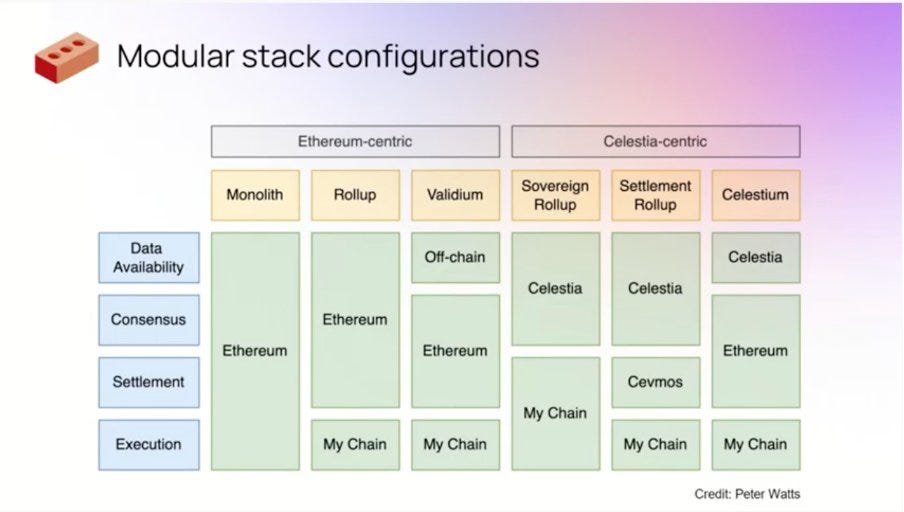Monolithic blockchains have been criticized for failing to solve the Blockchain Trilemma ⛓
Are modular blockchains the future paradigm for the underlying blockchain infrastructure?
Will @CelestiaOrg be the new @ethereum?
Celestia vs Monolithic blockchains: 🧵👇
1/
The Blockchain Trilemma:
It is difficult for a blockchain to achieve scalability, decentralization & security all at once
Only two of them can be solved simultaneously
But to gain mass adoption, blockchains must be scalable while maintaining decentralization and security
2/
There are four blockchain operations:
• Consensus - To verify true transactions
• Data availability - The availability of transaction data
• Execution - Process transactions to transition the blockchain b/w states
• Settlement - To verify proofs, settle disputes, etc.
3/
The predominant type of blockchains being used today are monolithic blockchains - which handle all of the blockchain operations on a single layer
And clearly, monolithic blockchains have not solved the "Blockchain Trilemma"
4/
Monolithic blockchains also face constraints such as:
• Nodes must re-execute transactions to check the validity
• The blockchain is bound by the resource capacity of its nodes
• Security & decentralization must be sacrificed to achieve scalability
5/
• Data availability is expensive on major L1s such as $ETH
• Developers are stuck with limited customizability over a single VM
• It is challenging for developers to launch a native token and create a consensus mechanism just to build an independent monolithic blockchain
6/
So how does a modular blockchain solve these problems?
A modular blockchain focuses only on a few operations while leaving the rest to the other layers that co-exist as a modular stack
A modular stack is the combination of individual modular blockchains that work together
7/
Modularity relies on specialization!
Each layer can only do specific operations that are assigned to them
A modular blockchain may often perform two or more functions
By distributing operations, the Modular Stack can solve the blockchain trilemma together as a "SYSTEM"
8/
So, what is @CelestiaOrg?!
Celestia is a modular blockchain that only orders and publishes transactions and does not execute them
It specializes in consensus & data availability, off-loading execution to separate chains
9/
Celestia provides three basic configurations:
1. The sovereign rollup:
A sovereign rollup uses Celestia for consensus & data availability
This means that you can fork only the settlement & execution layers & not worry about losing the security of the original chain
10/
2. Settlement Rollup:
A settlement rollup uses Celestia for consensus & data availability which also optimizes the settlement layer for other roll-ups
Rollups can be deployed on top of the @EvmosOrg (EVM Hub on Cosmos) settlement layer with the help of Cevmos
11/
3. Celestium:
Celestium is similar to Validium but it uses Celestia for Data Availability
The data availability on major L1s like $ETH is very expensive as everybody competes for data on a single chain
In Celestium, data is stored off-chain rather than on the L1 chain
12/
What makes Celestia better than others and why?
Developers can define their own execution environment which can be customized & optimized for specific use cases
Celestia provides consensus & security enabling anyone to deploy a blockchain as easy as a smart contract
13/
Celestia’s throughput scales with the number of users with the help of its unique feature (Data Availability Sampling) which enables a node to verify a block with a tiny sample of information
Modular blockchains are sovereign like L1s despite the utilization of other layers
14/
New blockchains can simply utilize existing modular blockchains for the components they wish to off-load, which allows new blockchains to be bootstrapped efficiently
Modular blockchains allow for effective scaling because they don't have to handle all the functions
15/
Modular blockchains might represent a new paradigm that fundamentally alters the infrastructure of the blockchain
They offer various advantages such as customizability, sovereignty, and scalability, whereas monolithic L1s continue to ask external chains for assistance








